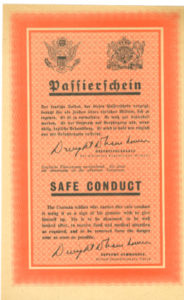One of the most effective pieces of propaganda that came out of the Office of War Information (OWI) was the Safe Conduct Pass leaflet, which guaranteed safekeeping for the captured German soldiers. These passes were shot off of airplanes in non-exploding containers and drifted to land like leaves from a tree.

The concept of safe passage documentation was not new, having first been recorded in biblical times. In the middle ages, when a Christian wanted to travel to the Holy Land through an Islamic run territory, they needed transit papers to ensure safe travel to Jerusalem. At the Geneva Convention of 1929, a specific effort was made to revise the rules of the treatment of prisoners of war, especially in relation to eliminating reprisals and collective punishments.
The Safe Conduct Pass in World War Two was produced by the OWI-SHAEF Psychological Warfare Division working in close conjunction with their British counterpart. Early in the war, the British, Russians and French were all distributing surrender leaflets, but there was no uniformity to them, and some of the rules were not the same depending on who produced them. Once the United States was involved in the war, and after the collective British and American effort, a uniform and official Safe Conduct Pass was created.
The final version was first distributed over the continent after the Normandy invasion on June 6, 1944.
What They Were Made Of
It was printed on very thin paper, almost like a stock certificate, and contained the seal of the US and the royal crest of the United Kingdom. It also contained the facsimile signature of SHAEF Supreme Commander Dwight D. Eisenhower. If the Safe Conduct Pass was printed in French, then the seal of France was added to the Pass. Overall, it looked very official and authentic, something the Germans liked to see, even in the midst of the chaos of war. Here’s what the passes said:
SAFE CONDUCT
The German soldier who carries this safe conduct pass is using it as a sign of his genuine wish to give himself up. He is to be disarmed, to be well looked after, to receive food and medical attention as required and to be removed from the danger zone as soon as possible.
Dwight D. Eisenhower,
Supreme Commander,
Allied Expeditionary Force
The following rights were outlined for the pass holder, on the reverse side:
- Immediate removal from the danger zone.
- Decent treatment as befits soldiers.
- The same food as American soldiers.
- Hospital care.
- Postal privileges.
- Return home after the war as soon as possible.
As the war carried on and German soldiers were taken prisoner, the enemy detainees gave the Allied Psychological War officials feedback on the Safe Conduct Pass. Passierschein, as they were known in German, were revised to reflect their input. The German text was moved above the English version, including a note that the German message was exactly the same as was written in English. In addition to his written name, the signature of General Eisenhower was added, as the Germans did not recognize his writing. Several colors were used but they settled on the red version as it was the most visible. (Green often faded into nature.) The Passierschein could be used for one or more soldiers. All they had to do was wave it in the air as Allied troops approached.
Allied Psychological War leaflet creators wanted to emphasize that the prisoners of war would be treated well as outlined in the Geneva Convention. Once again, the overarching theme was the projection of America as a strong, reasonable and fair country, that our intentions were honorable, and that we did not want to take over any country. The goal? To break down the German will to continue to fight in the face of overwhelming force exhibited by the Allies.
How Effective?
There is a good discussion of the effectiveness of the U.S. Psychological Warfare Leaflets in the following article.
Clip from “The Voices of Freedom,” in Army Talk’s, Vol. IV, No. 18, dated 16 September 1945 (Source: psywarrior.com):
Within a very few months after the landings In Normandy, American and British PW Interrogators were able to gather plenty of evidence to show that SHAEF appeals, by voice and leaflet, were getting results. In October 1944, it was officially reported that 77% of prisoners taken by the Allies had read one or more of the leaflets…About 80% of the prisoners taken on the Brest peninsula had leaflets in their Possession. On one occasion, three Germans surrendering had only one leaflet for the trio. They gave themselves up, each with one hand held high and the other clutching a corner of the precious document…Another German gave himself up with the statement that he had “a document bearing General Eisenhower’s personal signature.” In one day, 44 men of the 256th Volksgrenadier division deserted to a Third Army unit and nearly all carried the Safe Conduct surrender pass.
Several hundred million leaflets, including Passierschein, were dropped over Western Europe during the course of the war. Leaflets were newsworthy through a propagandist’s lens. In her role on the French Desk, I’m confident my mother would have helped coordinate the drops, based on military input of where the next major battle would be fought.
Bonus Nugget: Safe Conduct Passes were likewise used in Viet Nam, encouraging the Viet Cong and the North Vietnamese soldiers to give up. The pass was very successful in Vietnam as well.
